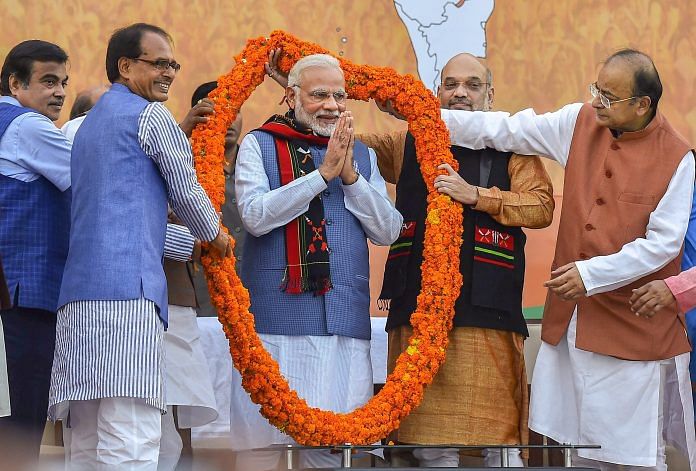The Modi government has realised the futility of the perception of cozying up to corporates at the cost of the poor very early in its tenure.
It isn’t jobs. It isn’t anti-corruption. It isn’t economic reforms. It isn’t even the Ram Temple. It’s welfare.
If there was one unambiguous signal needed on what the Prime Minister Narendra Modi-led BJP will use as its main poll plank in 2019, it came at a meeting of the party’s Chief Ministers and deputy Chief Ministers this week. Modi urged the leaders from 14 BJP-ruled states to accelerate the implementation of welfare schemes, and meet targets of flagship programmes.
With this, the BJP has clearly underlined what it intends to sell to its voters in the run-up to 2019. Promise for change, which had been its key agenda in 2014 and in several states, is not the song it can play again as it battles the baggage of incumbency. A narrative of being squeaky clean, non-corrupt and hard-on-the-rich might not be the easiest to sell, despite the perception of Modi being “personally clean”. Particularly after bad PR incidents like questions over party president Amit Shah’s son’s rising fortunes or the recent scam involving diamantaire Nirav Modi. Demonetisation may have established Modi as a decisive leader, who took a step against dubious money, but it was too long back to have immediate resonance before the next general polls.
Welfare, along with its Hindutva narrative, is most definitely going to be the main focus in 2019, just as it has been to a large extent in assembly polls since 2017. The Modi government realised the futility of the perception of cozying up to corporates at the cost of the poor, rural masses and farmers very early in its tenure, when it decided to do a stunning U-turn in its approach and withdraw its measures to dilute the Land Acquisition Act. Sources in the BJP say if there is one attack by the Congress that really rattled Modi, it was Congress president Rahul Gandhi’s ‘Suit Boot ki Sarkar‘ jibe.
Free LPG connections under the Ujjwala scheme, the coverage of which was expanded in this budget to include 80 million poor families, houses under the PM Awaas Yojana that promises ‘housing for all by 2022’, toilets, livelihood in rural areas and, of course, the promised health insurance scheme will be the hot selling points going ahead.
It is now no secret that Ujjwala was crucial in giving the BJP the necessary push in the Uttar Pradesh assembly elections among the poor. Ujjwala and PMAY have done particularly well, leaving a clear stamp of this government in the minds of the rural poor, and the BJP government will hope to similarly make the health insurance scheme its USP. The health insurance scheme will be used as bait, urging people to vote it back so it can fulfil its promise.
The Modi government is trying to develop its own franchise of social welfare initiatives that can overshadow that of the UPA government. The Union Budget speech this year was the first budget speech that did not separately and specifically mention the flagship MGNREGA and its allocations, achievements, plans since the scheme was introduced in February 2006 (except during the vote-on-account in 2014). Instead, its own initiatives for the poor got prominent mentions.
The idea behind polishing its welfare image is also to counter the massive agrarian distress in various parts of the country.
No government that has won with such a large majority has been re-elected in India in close to 50 years. Former PM Indira Gandhi swept elections in 1971 but in 1977, she was swept aside. In 1984, her son Rajiv Gandhi won with the biggest majority ever; in 1989, he was out. Whether a social welfare emphasis – or the claim of delivering welfare – will be enough for India’s first truly right wing PM to defy recent history and win a second term will be interesting to see.




Welfare, material well being, more generally, is what all governments are expected to deliver to their citizens. Only a small part of that can be provided from the government budget. The bulk of it has to come from the economy delivering more income to the average household. If farm incomes have grown 1% annually over the last four years, the gap is too wide to be bridged by a few good schemes like LPG. So many families are dipping into savings to sustain modest consumption. The shifting political narrative since 2014 amidst a becalmed economy does not hold promise of another tsunami, one fears.